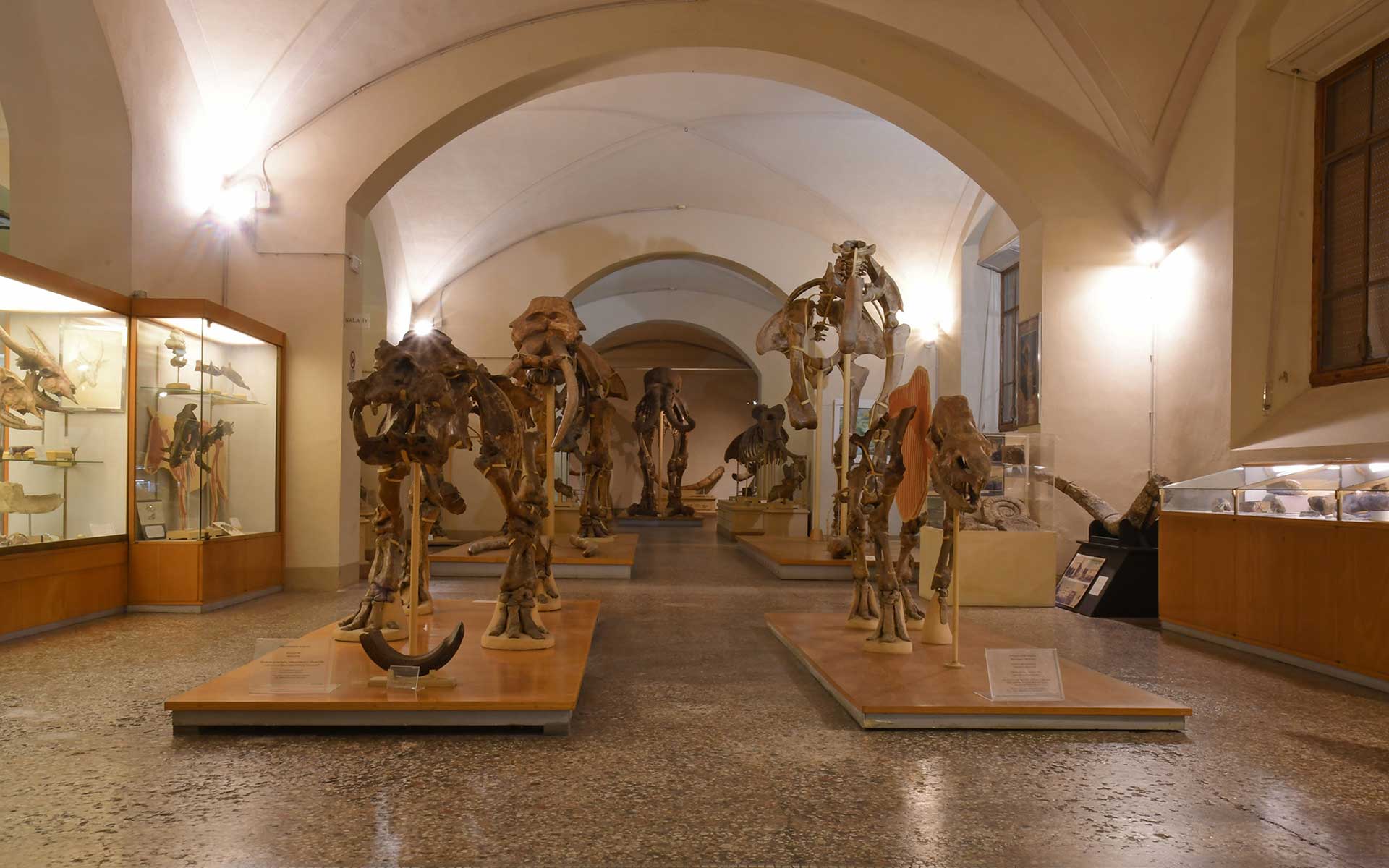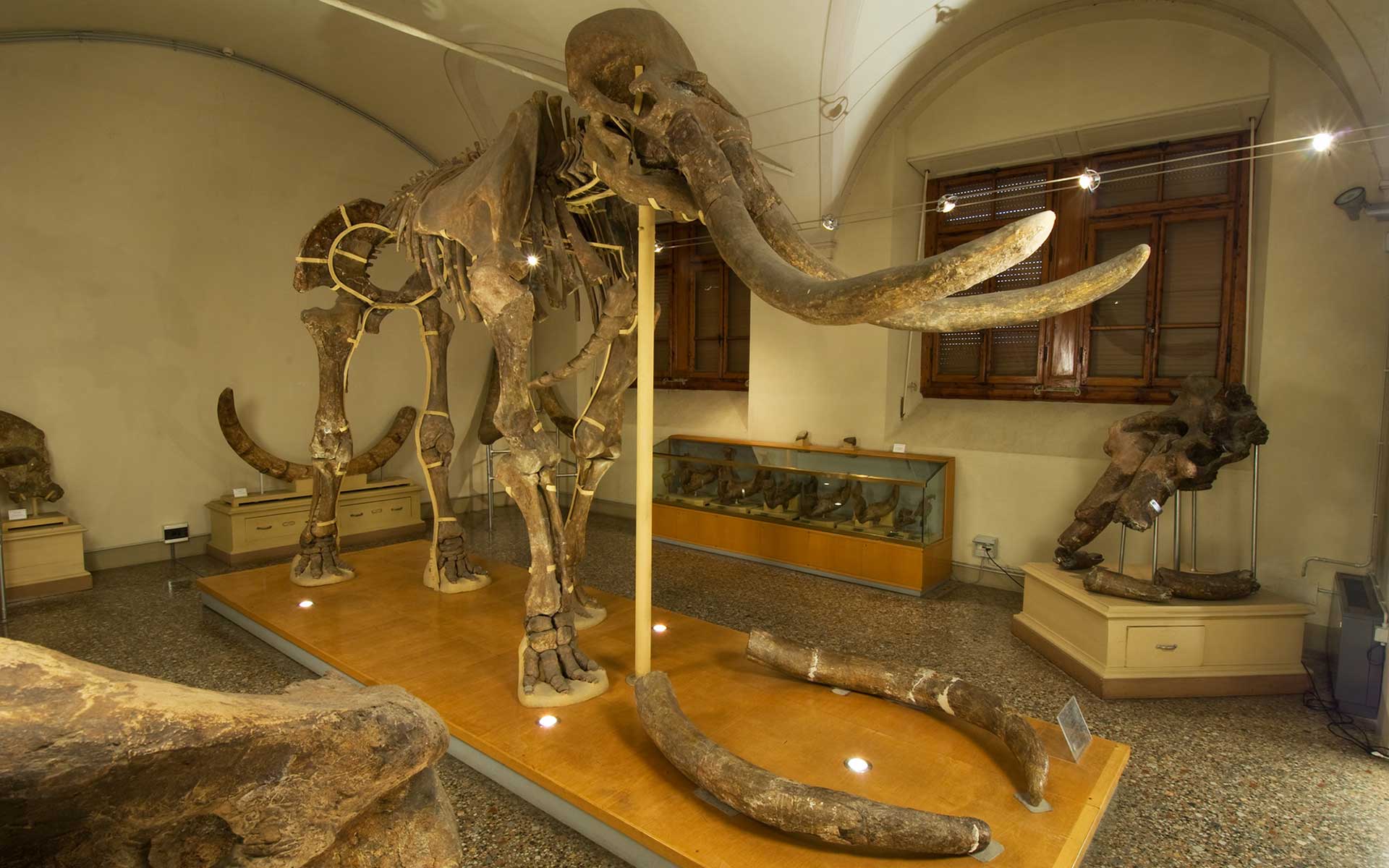
On the forefront: Hippopotamus antiquus (holotype) and Stephanorhinus etruscus; behind them: Anancus arvernensis and Mammuthus meridionalis; to the side Homotherium crenatidens and Sus strozzii (holotypes).
Housing institution
Museo di Storia Naturale, Università di Firenze
Location
Via La Pira 4, 50121 Florence, Italy
43.7784079, 11.2601206
Homepage
On the forefront: Hippopotamus antiquus (holotype) and Stephanorhinus etruscus; behind them: Anancus arvernensis and Mammuthus meridionalis; to the side Homotherium crenatidens and Sus strozzii (holotypes).
A collection of fossil mammals functional to the advent of modern earth sciences and the development of European mammal biochronology.
- Geo-collection description
Fossil mammals of the Arno valley (Valdarno, Tuscany, Italy), including articulated, nearly-complete and mounted skeletons, are kept and exhibited in the Museum of Natural History, University of Florence (three curators of geo-paleontological collections). Recovered from both continental and marine Upper Pliocene-Pleistocene strata, the Valdarno collection includes type specimens of iconic animals described by Georges Cuvier (Ursus etruscus, Megantereon cultridens), Anselme Desmarest (Hippopotamus antiquus), Filippo Nesti (Mammuthus meridionalis), Hugh Falconer, Igino Cocchi, Charles Immanuel Forsyth Major, Karl Weithofer, Emilio Fabrini, Domenico Del Campana, Giovanni Merla and Augusto Azzaroli. One marine species is by Giovanni Capellini (Idiocetus guicciardinii). The Valdarno record was discussed also by William Buckland (Rudwick, 2005), Charles Lyell and Charles Darwin.
The collection has deep historical roots. Bones of Valdarno elephants are mentioned in 1596 by Andrea Cesalpino, keeper of collections of Gran Duke Ferdinand I, and in Nicolas Steno’s De Solido, written for Grand Duke Ferdinand II in 1669. Fossils were on show at the Museo di Storia Naturale opened in 1775 under Grand Duke Pietro Leopoldo, the first public museum aimed at the “education of the citizen”. Specimens of the 18th-century, famous Targioni collection were acquired in 1838.
- Geo-collection value
Fossil mammalian bones of the valley of the Arno river, in Tuscany (Italy), were collected and hosted in Florence since the late Renaissance and presented as means to reconstruct geohistory. They first acquired a modern geological meaning through the work of Georges Cuvier, who formally and informally described several species and closely interacted with Filippo Nesti, the first modern curator of the Florentine collections. British paleontologist Hugh Falconer, author here of Leptobos etruscus and Stephanorhinus etruscus, claimed that “the Florence collection of mammalian remains from the Pliocene deposits of the val d’arno is unrivalled in Europe both for their abundance and for the perfect condition in which they are preserved” (Dominici and Cioppi, 2018). Studied without interruptions by key figures of Italian and European vertebrate paleontology, the collection has been of paramount importance for Augusto Azzaroli to define faunal units of Villafranchian biochronology (Rook and Martínez-Navarro 2010). Recent excavations allowed for the modern study of bone taphonomy (Mazza et al. 2004), keeping alive the use of the fossil record to explain evolutionary theory and biological extinctions to the wider public (Dominici and Cioppi, 2012). 3D models of most types are available for both study and educational purposes.
- Reference
- Mazza P. Bertini A., Magi M. (2004). The Late Pliocene Site of Poggio Rosso (Central Italy): Taphonomy and Paleoenvironment. Palaios, 19, 227-248.
- Rudwick M.J.S. (2005). Bursting the Limits of Time: The Reconstruction of Geohistory in the Age of Revolution. Chicago, University of Chicago Press, 708 p.
- Rook L., Martínez-Navarro B. (2010). Villafranchian: The long story of a Plio-Pleistocene European large mammal biochronologic unit. Quaternary International, 219, 134-144.
- Dominici S., Cioppi E. (2012). Evolutionary Theory and the Florence Paleontological Collections. Evolution: Education and Outreach, 5, 9-13.
- Dominici S., Cioppi E. (2018). All is not lost: History from fossils and catalogues at the Museum of Natural History, University of Florence. In G.D. Rosenberg e R.M. Clary (eds), Museums at the forefront of the history and philosophy of geology: history made, history in the making, Geological Society of America Special Paper, 535, 59-80.

